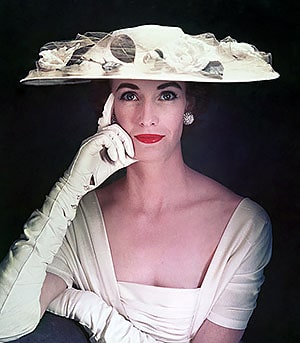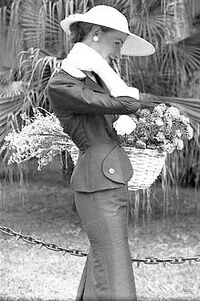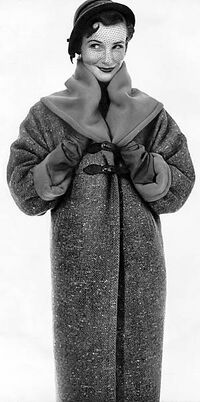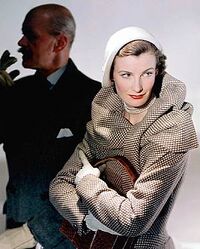Lea Kersed
Lea Kersed | |
|---|---|
 | |
| Deputy Prime Minister of Gylias | |
| In office 30 May 1986 – 9 September 1988 | |
| Prime Minister | Filomena Pinheiro |
| Personal details | |
| Born | 11 February 1933 Taryn, Xevden |
| Died | 9 September 1988 (aged 55) Off the coast of Landráy, Nauras, Gylias |
| Political party | Conservative Party (1969) Civic National Party (1969–1988) |
| Occupation |
|
Lea Kersed (11 February 1933 – 9 September 1988) was a Gylian model, author, and politician. She was Gylias' Deputy Prime Minister in the Filomena Pinheiro government. She is one of the most influential Gylian conservatives, winning a thorough victory in the "constructive"–"recalcitrant" battle and establishing the National Bloc, Gylias' main conservative electoral bloc.
Beginning her career as a model, Lea entered politics in the 1969 federal election, where she was the only Deputy elected from the Conservative Coalition. She spearheaded the dissolution of the CC through a process of entryism by "constructives", and subsequently established the Civic National Party and the National Bloc.
Lea's good looks, elegant personality, and glamorous image helped drive her to national popularity and establish the NB as a strong progressive conservative force in Gylian politics. During the wretched decade, she was a tenacious opponent of the Aén Ďanez government, and repeatedly pushed for a grand coalition of conservatives, leftists, liberals, and centrists. This came to fruition after the Ossorian war crisis, and she joined the Filomena Pinheiro government as Deputy Prime Minister.
In the run-up to the next federal election, there was strong speculation that the NB would win, and Lea would become the first conservative Prime Minister of Gylias. However, Lea died in office on 9 September 1988, drowned while swimming in the Varuna Ocean. Her death caused a fracture in the NB, with the Union for Freedom and Prosperity splitting off in 1989, and the NB would remain in opposition for three decades at the federal level.
Early life
Lea Kersed was born on 11 February 1933 in Taryn. She grew up in poverty; her parents took various odd jobs to survive and make money.
The establishment of the Nerveiík Kingdom led to an improvement in the family's fortunes. Her parents began working for the state — her father as a secretary for a National Syndical Organisation, and her mother headed a local chapter of the Women's League. Lea began attending primary school.
The family fled the Kingdom after the 31 December 1947 coup that brought to power the Tymzar–Nalo regime. They embarked on a large boat in Ryðai along with many other refugees and subsequently sailed to Iárus island, taking refuge in the Free Territories.
Lea's politics were marked by her childhood in the Nerveiík Kingdom and her family's move to the Free Territories. She often referred to the warm welcome the family received in Iárus, such as in her maiden speech to the Chamber of Deputies:
"I disembarked with my parents in Iárus, terrified that the life we'd known had just gone up in flames and not knowing what to expect next. When it came our turn to be processed, the clerk took down our names, and asked our backgrounds. When he found out my parents had worked for the Nerveiík Kingdom, he took it on himself to announce loudly, 'Attention everyone, we have two functionaries from the Kingdom with a daughter. Treat them as guests of honour!' And my parents cried from joy.
We got a generous settlement package, a nice house we shared with the loveliest Gylian family you could meet, and we were even given nice clothes so that we wouldn't look shabby in public. And I have a vivid memory that once we were getting our rations, a People's Army soldier passed by and sneered at us for being 'Nerveiíkans'. To my surprise, he got the mother of all tongue-lashings from the commander until he apologised.
From that day, I've had nothing but admiration for the Free Territories. They've fought a brutal war to rid themselves of a murderous regime, but at home they were draconian about treating people humanely. I even got the impression they went out of their way to treat us well because my family had been Nerveiík functionaries. And since then, I've felt proud to live in a country that treats its enemies ruthlessly but its adversaries with the greatest respect."
Modeling career
Having continued her education in volunteer classes, Lea began working as a model in the Free Territories.
Fellow model Isabel Longstowe praised Lea as "a stunning beauty". Her trademarks included a striking widow's peak, a perfectly symmetrical rectangular face, and a fashionably slender body.
While working as a model, Lea met her husband, Nary Kersed. The two would be exclusive collaborators for the rest of their careers. Nary praised Lea's beauty as "frozen, permanent, it does not age". His portraits of his wife show her gently smiling and a "witty underplay" to the scenes she's set in — more often than not, an incongrously buttoned-down elegance in contrast to prosaic surroundings.
Lea gained renown as a model during the Golden Revolution, and she and her husband regularly socialised in renowned circles, among artists, musicians, models, and broadcasters. She had a lifelong friendship with Ludmila Canaşvili, and campaigned for her during the 1968 presidential election. This experience stirred her interest in politics.
Political career
Lea was inspired by Ludmila to research conservatism, and became a Hannaist. At the time, Gylian conservatism was at a low ebb, weakened by the "constructive"–"recalcitrant" battle, with many moderate conservatives having instead joined the Centre Group or Non-inscrits.
Lea joined the Conservative Party just as the 1969 federal election campaign started, and ran for a circonscription in Nerveiík-Iárus-Daláyk. She campaigned heavily in her district, to the point that even her Progressive Alliance opponents praised her as a talented campaigner. She ran an entirely personal campaign, with materials carrying only her name and no mention of her political affiliation.
Aided by recognition from her modeling career, she finished 4th in the final count and was elected, becoming the Conservative Coalition's only deputy in the 2nd Parliament. Iulia Edver was famously dismissive at first, commenting that "They had to put up a model who remained tight-lipped about her actual politics to even have a chance of getting elected."
Leader of the National Bloc
Once elected, Lea disavowed the CP, and manipulated its internal rules to seize power as its leader and expel "recalcitrants". She disbanded the CP and established the Civic National Party, its name an homage to Ossoria's Crown Nationalist Party, a leading model for the new party.
She encouraged others to apply similar strategies to the other CC parties, and entryism from "constructives" to seize control. These tactics led to the destruction of the CC and its replacement by the National Bloc. A political realignment ensued, with many "constructives" elected under the CG or independent banner joining the NB parties. The NB's good performances in the first regional elections of 1970, municipal elections of 1970, and the presidential election of 1975 raised expectations they would become a serious contender in the next federal election.
The NB finished third in the 1976 federal election, and formed the official opposition. Although Lea was credited with obtaining the breakthrough that had eluded Sasa Ruişela, she lamented that the result showed how much of an uphill climb they still had to win over voters.
During the wretched decade, she was a tenacious opponent of the Aén Ďanez government, and repeatedly pushed for a grand coalition of conservatives, leftists, liberals, and centrists, to resist the authoritarianism of the left and right. She refused to compromise on this principle, both as a means to win support from non-conservative voters, and, in her husband's words, "a personal feather in her cap. I think she wanted to gain immortality by being the first to have the conservatives and the socialists shake hands."
Following the 1980 federal election, she was given the mandate by President Reda Kazan to form a government. Her grand coalition proposal was narrowly derailed by the PA "getting cold feet", which deprived it of a majority.
Frustrated with the impasse, she ran for the presidency in 1982. She finished third, with 15,1% of first preference votes, and didn't advance to the final round.
Lea's hard work as opposition leader and consistent anti-Aén stance ultimately attracted more voters frustrated with opposition disunity, who blamed the other blocs for failing to unite and remove Aén. The 1985 federal election was Lea's greatest triumph: the NB finished first and won a plurality, with the highest tally of deputies (100) ever won by a Gylian electoral bloc.
The triumph obscured growing internal tensions within the NB. The Civic National Party, National Party of the Republic, and Popular Democratic Union stuck firmly to Hannaism, but the Free Economy Party and Independent Freedom Party had moved to the right, and grew increasingly neoliberal.
Deputy Prime Minister of Gylias
The Ossorian war crisis of 1986 galvanised the opposition, which succeeded in toppling the Aén Ďanez government, and formed a grand coalition, the Filomena Pinheiro government. Lea had ruled herself out of consideration as Prime Minister, and instead supported the independent deputy Filomena Pinheiro, feeling that her non-partisan image would be more acceptable for the opposition to rally around. Filomena appointed Lea Deputy Prime Minister, in recognition of her long opposition to Aén. The NB obtained 5 cabinet posts in total, marking their first participation in a federal government.
Lea took on a visible role as Deputy Prime Minister, and strongly supported Filomena's "New Course", particularly the crackdown on the Revolutionary Rally and Front for Renewal of Order and Society, the most extensive since the Lucian Purge. Lea and Filomena became close friends in government, and formed an effective team in public appearances, where Lea's elegance compensated for Filomena's low-key and contemplative manner.
Lea observed the dérive au droite with concern, and was determined to make a stand and expel the FEP and IFP from the NB before the next election. In a party meeting, she stated, "We can't allow any sort of ambiguity or doubt in the Gylian voter's mind whether the National Bloc stands for conservatism as a positive force or a destructive force."
Public image
Throughout her political career, Lea capitalised on her physical beauty and glamorous personality to appeal to voters. She did her best to present the "elegantly old-fashioned" image that characterised Gylian conservatism. She always appeared in public meticulously dressed in Levystile suits, giving her an image as a "slick" politician.
Ideologically, Lea supported the Gylian consensus, but mainly distinguished the NB through its stances on communitarianism, social corporatism, municipalisation, and statism. She was skeptical of whether Gylias could manage to abolish the state entirely, and her own model was closer to a night-watchman state, protecting direct democracy and providing coordination where necessary.
For most voters, Lea's "playfully inscrutable smile" was her defining trademark. She eagerly used this in her campaign material; one of her famous posters showed her smiling accompanied by the simple caption "The National Bloc will please Gylias".
Lea's experience in relocating to Iárus gave her a lifelong appreciation of the adversary–enemy distinction. She was known for going out of her way to befriend politicians from the Progressive Alliance, Liberal Union, and Centre Group, and said that her dream was to hear others say, "I don't agree with Lea at all, but she's a wonderful friend." One of her proudest achievements in this regard was befriending Iulia Edver, who had been dismissive of her when she was first elected deputy.
Although firmly opposed to reactionism, Lea had a degree of sympathy for social conservatism, mainly in nostalgia for older styles of appearance. She noted with amusement that "Reda is even more conservative than us" due to the President's tongue-in-cheek advocacy of stricter dress standards, and would remark that she wished Reda had been the leader of the Progressive Alliance instead.
Private life
Lea married photographer Nary Kersed in 1957, on her 24th birthday. Nary took her surname upon marriage. The marriage lasted until her death, and they had two children, Simon and Sue.
Lea and Nary had a happy and loving marriage. Acquaintances noted that Nary was in awe of his wife, referring to her as his "muse", and the two regularly expressed affection by lightheartedly teasing each other. Lea jokingly forbade Nary from wearing casual clothes at home and insisted he wear a three-piece suit to look as sharp as she did, to which he obliged.
Death
Lea was an avid swimmer throughout her life. One of her favourite swimming spots was the Varuna Ocean coast near Landráy. On the morning of 9 September 1988, she went to Landráy with her family and two of their neighbours. They went by bicycle to a local beach where they started swimming. Around 12:12, Lea was suddenly caught in a rip current and drowned at sea. Nary remembered: "She didn't raise her arms or cry for help, she just slipped beneath the waves and that's the last time we ever saw her."
Despite a massive search conducted by the Gylian Police and the Gylian Naval Self-Defense Force, Lea's body was never recovered.
Legacy
Lea is a major figure in the history of Gylian conservatism, and is credited with establishing it as an electoral force by ending the "constructive"–"recalcitrant" battle that had plagued it since the Free Territories.
Her death destabilised the NB and hastened the Union for Freedom and Prosperity's split in 1989; the NB would remain in opposition until the 2020 federal election.
She was the second Deputy Prime Minister to die in office after Aliska Géza. Like Aliska, she gained a reputation as "the Prime Minister who never was", and appears often in Gylian alternate history and counterfactual history works, which speculate on how she would have fared as Prime Minister and its possible effect on Gylian politics.
A public swimming pool in Landráy is named after Lea. Although this is often regarded as black humour, Nary himself stated that "it's what Lea would have wanted. She would've loved it, and she would've laughed heartily."


